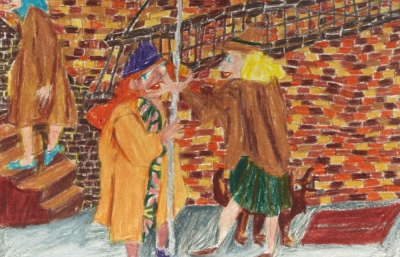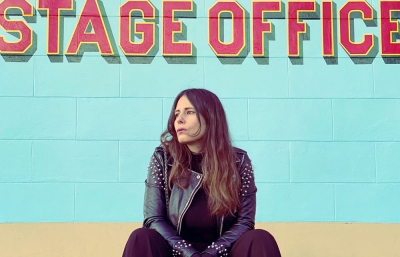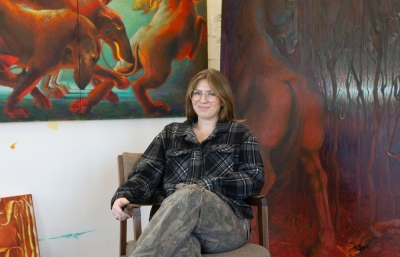Koichi Sato
The Splendid Sloppy
Interview and portrait by Sasha Bogojev
“I just want to paint with my hand moving,” and that sums up my conversation with Koichi Sato at his studio in Manhattan’s Chinatown. Look for a deeper, more elaborate articulation about his practice and connection with his work, and you might be missing the point.
In his earlier life, nothing indicated the direction his talent would take and that he'd become an accomplished painter showing work at galleries worldwide. Without an artistic education or progeny, Sato developed a distinctive visual language and painting style unshackled by traditional forms and rules, or his even own expectations. Using art as a tool to discover and connect with his adopted homeland, he delved into music, sports, cinematography, history, and popular culture, and, through his portraits, managed to create a cultural link between his Japanese upbringing and the creative free spirit around him.
At age 35, he embarked on an art career, fueled by unbridled curiosity, unburdened by fear of failure, and backed by the confidence of years, his first artistic steps spontaneously sincere. As you'll see from this conversation, nothing has changed.

Sasha Bogojev: I know you didn’t go to art school or come from a family that was deeply involved in making art, so how did this all come about?
Koichi Sato: I came over here for the first time, to New York, as a student. My major was film. I quickly realized I worked well with other people, so I kind of gave that up and switched to editing. I don't know, it seemed like I lost my passion for movies, so then I switched to graphic design.
In the middle of your film studies?
Yes, so then I went to Parsons, and I met so many people, like artists and illustrators. At the time, I didn't care what they were doing. I just wanted to do graphic design myself. So I graduated and then I started working with other graphic designers, which led to me meeting Tomoo Gokita. I saw his illustrations for the first time in a Japanese fashion magazine, and I found out he was also an illustrator, and this all led to me finally realizing, “Oh my god, art is great!” When I went to his show in New York, my friends introduced me, we started drinking and...
I was waiting for this crucial moment in the story…
Yeah, the beer. Drinking. I think it was then that I wanted to do something like draw or paint. At that time, I wasn't serious, but that is when I started drawing.
When was this?
I was 35 years old. Yes, pretty old to start doing that, but okay, during the daytime I worked, but at nighttime, I was drawing. And I loved it. I loved the drawing, and really got into it.

What type of things were you drawing at that point?
In the beginning, I wanted to be more of an illustrator, kind of a fashion illustrator. I sent my work to agencies and magazines, and they rejected them. But I still liked drawing. I was really into it. I never showed the drawings to Tomoo. At that point, one of my friends asked me to share a studio space for drawing, or painting, or whatever. So I got a space in Brooklyn. In the beginning, I was just drawing, and the two other friends there were painting, so that got me inspired, and I just started painting.
I love how organic this was, so unplanned. How did your technique and interest in portraiture develop?
In the beginning, I just played with it, but my thing was always the people. When I started drawing, I always drew people. The same thing with the painting, I just wanted to paint faces. People's faces. So I'd look at a magazine and chose to paint this guy and this lady. It's my intuition.
And what about the technique? How did you develop what I would call your "patchy" manner?
I was inspired by Jules de Balincourt's painting. When I went to his show, I noticed that he didn’t paint a lot of faces, but there were landscapes with people. And I really liked those. I don't know how to describe how I use color or any particular techniques, but I just want to paint whatever I want to do. I just tried to do what I like, and then throw away what I didn't like. That's the best way to explain how I developed my painting style. I just use what I like the most.
So you're just playing with the paint…
I try to find a way to paint, but I don't think much about the painting techniques. For me, technique is secondary. I'll go, "I like this, this part. I did it this way. I didn't like this part, so I'll take that out."

I always think of mosaics when looking at your work. Was this something you were interested in?
No, never. People point out, "Oh, your technique is blah, blah, blah," but I never analyze it. I just want to paint with my hand moving.
That is how far you plan! Your hand moves, the paint is on the canvas, and—done!
Yes! [laughs]
Are you afraid that you might run out of all the things you wanted to try? That you'll get done playing and exploring?
I started at 35 years old. If I went to art school and my major was painting or fine arts, maybe I'd feel the pressure. Maybe I'd be nervous about having to make a living from painting. But I don't have that pressure. I just enjoy the painting.
That's a great position, a great attitude, and I think that's visible from your work because it’s so honest and playful. Are there certain types of people you like to paint? How do you select references for your work?
When I started drawing, I really liked the old magazines, especially old porn or adult magazines like Playboy. I collected those and I'd look, pick certain people, like someone weird, a shady guy, and would start drawing that kind of face. My friend told me it was kind of sick and disgusting, but good work. So, I just kept that. To me, these characters are like my friends: they like beer, they're very trashy.
It seems like your work is grouped in categories; for example, you have sportsmen, ethnic groups, and these shady people. Do you categorize your subjects in that way?
For now, if some gallery asked me to show, I would not think of a theme. In my last show with Bill Brady Gallery in January 2020, my theme was sports. It basically depends on my mood. That's why I don't want to do commissioned work, because I lose my passion for painting. I just want to paint whatever I want to. I don't want to be asked. I can't work like that.

Once you have the references, do you compose them digitally? They actually appear to be grouped.
Actually, I'm just a very sloppy guy, so I just cut out pictures and put them together. Maybe I'm going to put this guy here, put this guy there, and that's how I'm going to paint them.
How much do you change them from what they originally look like?
Oh, a lot! Sometimes they naturally just change a bit, and sometimes it's totally different people from the original image.
A lot of the works are also focused on American culture, history, sports, and such. Is that your way of exploring the country that you moved to?
Yeah, because as kids in Japan, we loved American culture, American magazines, American music. I watched American TV all the time and was very familiar with the American character and American people.
I'm wondering, does that seem exotic or cool to you? What is the attraction?
I think it's a combination of things maybe. Exotic, also like very close, and also very idolizing.
If you didn't move to New York and had started painting in Japan, do you think your work would be any different?
It would be totally different, I think.
How do you think living in the US influences your work?
New York is very free. People say nothing, I can do whatever I want. Some Japanese friends say to me, "Oh you started drawing or painting at 35 years old, and in your 40s, you got a show, so many shows? That's crazy!"
But that happened in the US. I think if I wasn't here in the US, it wouldn't happen. I feel like in Japan, I wouldn't be able to show what I think or what I want to do. In general, Japanese just don’t express themselves too much, so it's harder. I came here when I was 22 years old, but always felt that way.
Describe your experience with getting recognition and experiencing a demand for your work, as well as people collecting and appreciating it. Does that pressure you or change the way you approach work?
First, I was very nervous. I mean, after the first show, so many people asked me about work, so that was a bit of pressure. But now I just relax, because I realize I can do whatever I want, and I don't think so much about people's opinions and stuff. But I really appreciate when people like my paintings. Especially since I paint whatever I like, and people want to buy it. I've heard many nice things. They say they appreciate me and thank me, and say, “Oh my god, that is amazing.” What a great job to have.

Since the scale of your work is getting progressively bigger, does that affect your work process or the way you structure things?
It doesn't change structure, but it definitely takes more time. I think they're kind of the same, but, with the bigger ones, there can be some struggle. I guess that has to do with being used to working at a certain scale, in a certain way.
I just realized that you fit more people in the bigger paintings. Is it that the people are always the same size, but the canvas decides how many of them will be included. Is that how it works?
In my last show with Bill Brady, the sports one, there were only two figures in one of the big pieces. But usually, the rectangle one fits six people, but the tall one is only two each.
Let’s talk about that sports series, for example. There are obviously a lot of jerseys and ephemera, so do you alter those?
There are changes, yes. As I'm working from different images, I might mix up things, not to add meaning, but just so it works in the painting. Some people that are die-hard fans might say that the painting or the outfit doesn't make sense.
How do you compose the backgrounds, which seem to be equally intricate and detailed. Are they also from a reference?
It depends on the scene. Like this one, the Japanese scene, I tried to put more traditional elements in it. This tree was very common at the time when such works were made. But the jungle one, for example, I just wanted to put more green, more jungle inside.
This shows how I'm very sloppy in a way. In the beginning, I was serious, like, "Okay, I want to do more jungle, more real jungle elements." But, at some point, I thought, "It's painting, so it has to be fun. It doesn't have to make sense."

I've noticed more animals in the recent works, and I even see E.T. in one of these new pieces. Is there a chance you'll incorporate more non-human characters in your work?
I want to describe more of America through a pop culture history and different characters, though I'm still thinking about what I'm going to add.
How have animals shown up in your work so far?
Sometimes there is a story behind it, like Native Americans and the turkey, maybe a little play on history. And sometimes there just is no meaning!
You often use evident racial stereotypes. So do you ever get criticized, and do you take that into account?
My subjects might be stereotypes, but they’re shown in a sarcastic way on purpose. For example, I have a painting of hockey players wearing the uniform of the Chicago Blackhawks. All players and uniforms are white, but the uniforms are printed with Indian faces. I just mix it on purpose, and nobody has criticized me so far. I met a Native American guy who said my painting is very funny, so who knows?
There is an element of playful innocence because of the way you paint, and the expressions.
I think innocence is the thing. I don't want to put something I don't like into my work. I only work with figures I like. So that's why many people think in a positive way when looking at the work. The people I paint are people I like, so no one takes offense.
So, no negativity in your work?
There's no intention because I can't paint what I don't like.
That's a good way to approach it. Is there a certain emotion or idea that you are intentional about?
That's what my teacher, Tomoo, told me: "The painting has to have a bit of funny.” So I just learn from him, you know. I want to make the work fun for the people.

Do you have any ideas or plans about moving back to Japan at any point?
I'm kind of going back and forth about it. Whenever I go back to Japan, it keeps changing. Of course, I know older places, and I go back and hang out with my old friends, but when I go over, I feel like a foreigner sometimes. I feel like I don't fit the culture.
Did you show your work in Japan?
No, never. I think Japanese people feel my painting is more like illustration. Even my friends in Japan, I don’t think they understand my paintings much.
Do you feel pressure about the idea of showing the work over there?
To me, there is no pressure. If I fail, I’ll go back to graphic design.
This is so much fun. I mean painting, it's just fun. This is a hobby I just found, and it takes up my whole life. It doesn't matter if work is sold or unsold. I just want to keep doing it. If I can't have a show in the future, I don't care, maybe I can draw or do something else. This is just too much fun.
@koichis49





